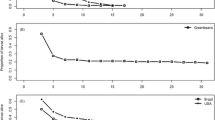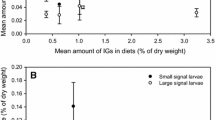Abstract
Phenolics have a role in defenses against herbivores, but the defensive functions of specific groups of phenolics are still poorly understood. For example, ellagitannins (a type of hydrolyzable tannin) are predicted to decrease insect herbivore performance, but the effect of different types of ellagitannins on generalist and specialist herbivores has rarely been assessed. Here, we test the effects of the dominant oligomeric ellagitannins of Oenothera biennis and other Onagraceae on herbivore performance. We fed artificial diets containing between 1 and 100 mg/g of polyphenol fractions comprised of varying amounts and compositions of dimeric oenothein B, the trimeric oenothein A and larger oligomers, to one generalist (Spodoptera exigua) and one specialist (Schinia florida) insect herbivore species. We compared the effects of these ellagitannin fractions on herbivore performance to the effects of artificial diet containing total phenolic extracts from O. biennis, which contained these ellagitannins as well as many additional phenolic metabolites including flavonoid glycosides and caffeic acid derivatives. Both the ellagitannin fractions and O. biennis phenolic extracts had strong negative effects on S. exigua and S. florida performance, with stronger effects on the generalist herbivore. Differences between the effects of the various ellagitannin fractions were small and depended on insect life stage. The defensive effects of these ellagitannins were large, with lethal concentrations as low as 0.1% of the diet. These results highlight the important defensive function of ellagitannins against specialist and generalist herbivores and the need to characterize the effects of these understudied phenolics.



Similar content being viewed by others
References
Agrawal AA, Hastings AP, Johnson MTJ, Maron JL, Salminen J-P (2012) Insect herbivores drive real-time ecological and evolutionary change in plant populations. Science 338:113–116
Anstett DN, Ahern JR, Glinos J, Nawar N, Salminen J-P, Johnson MTJ (2015) Can genetically based clines in plant defense explain greater herbivory at higher latitudes? Ecol Lett 18:1376–1386
Anstett DN, Chen W, Johnson MTJ (2016) Latitudinal gradients in induced and constitutive resistance against herbivores. J Chem Ecol 42:772–781
Appel HM (1993) Phenolics in ecological interactions: the importance of oxidation. J Chem Ecol 19:1521–1552
Baert N, Karonen M, Salminen J-P (2015) Isolation, characterisation and quantification of the main oligomeric macrocyclic ellagitannins in Epilobium angustifolium by ultra-high performance chromatography with diode array detection and electrospray tandem mass spectrometry. J Chromatogr A 1419:26–36
Baert N, Pellikaan WF, Karonen M, Salminen J-P (2016) A study of the structure-activity relationship of oligomeric ellagitannins on ruminal fermentation in vitro. J Dairy Sci 99:8041–8052
Baert N, Kim J, Karonen M, Salminen J-P (2017) Inter-population and inter-organ distribution of the main polyphenolic compounds of Epilobium angustifolium. Phytochemistry 132:54–63
Barbehenn RV, Jones CP, Hagerman AE, Karonen M, Salminen J-P (2006) Ellagitannins have greater oxidative activities than condensed tannins and galloyl glucoses at high pH: potential impact on caterpillars. J Chem Ecol 32:2253–2267
Barbehenn R, Weir Q, Salminen J-P (2008) Oxidation of ingested phenolics in the tree-feeding caterpillar Orgyia leucostigma depends on foliar chemical composition. J Chem Ecol 34:748–756
Barbehenn RV, Jaros A, Lee G, Mozola C, Weir Q, Salminen J-P (2009) Hydrolyzable tannins as “quantitative defenses”: limited impact against Lymantria dispar caterpillars on hybrid poplar. J Insect Physiol 55:297–304
Carmona D, Lajeunesse MJ, Johnson MTJ (2011) Plant traits that predict resistance to herbivores. Funct Ecol 25:358–367
Denno RF, McClure MS (1983) Variable plants and herbivores in natural and managed systems. Academic Press, New York
Feeny P (1976) Plant apparency and chemical defense. In: Wallace JW, Manse RL (eds) Biochemical interaction between plants and insects. Plenum Press, New York, pp 1–40
Felton GW, Summers CB (1995) Antioxidant systems in insects. Arch Insect Biochem 29:187–197
Fritz RS, Simms EL (1992) Plant resistance to herbivores and pathogens: ecology, evolution, and genetics. University of Chicago Press, Chicago
Harborne JB, Williams CA (2000) Advances in flavonoid research since 1992. Phytochemistry 55:481–504
Johnson MTJ (2011) Evolutionary ecology of plant defenses against herbivores. Funct Ecol 25:305–311
Johnson MTJ, Agrawal AA (2005) Plant genotype and environment interact to shape a diverse arthropod community on evening primrose (Oenothera biennis). Ecology 86:874–885
Johnson MTJ, Agrawal AA (2007) Covariation and composition of arthropod species across plant genotypes of evening primrose (Oenothera biennis). Oikos 116:941–956
Johnson MTJ, Agrawal AA, Maron JL, Salminen J-P (2009) Heritability, covariation and natural selection on 24 traits of common evening primrose (Oenothera biennis) from a field experiment. J Evol Biol 22:1295–1307
Johnson MTJ, Ives AR, Ahern J, Salminen J-P (2014) Macroevolution of plant defenses against herbivores in the evening primroses. New Phytol 203:267–279
Karonen M, Parker J, Agrawal AA, Salminen J-P (2010) First evidence of hexameric and heptameric ellagitannins in plants detected by liquid chromatography/electrospray ionisation mass spectrometry. Rapid Commun Mass Spectrom 24:3151–3156
Karonen M, Oraviita M, Mueller-Harvey I, Salminen J-P, Green RJ (2015) Binding of an oligomeric ellagitannin series to bovine serum albumin (BSA): analysis by isothermal titration calorimetry (ITC). J Agric Food Chem 63:10647–10654
Kim J, Pälijärvi M, Karonen M, Salminen J-P (2018) Oxidatively active plant phenolics detected by UHPLC-DAD-MS after enzymatic and alkaline oxidation. J Chem Ecol 44:483–496
McArt SH, Halitschke R, Salminen J-P, Thaler JS (2013) Leaf herbivory increases plant fitness via induced resistance to seed predators. Ecology 94:966–975
Moilanen J, Salminen J-P (2008) Ecologically neglected tannins and their biologically relevant activity: chemical structures of plant ellagitannins reveal their in vitro oxidative activity at high pH. Chemoecology 18:73–83
Moilanen J, Koskinen P, Salminen J-P (2015) Distribution and content of ellagitannins in Finnish plant species. Phytochemistry 116:188–197
Niemetz R, Gross GG (2005) Enzymology of gallotannin and ellagitannin biosynthesis. Phytochemistry 66:2001–2011
Normark BB, Johnson NA (2011) Niche explosion. Genetica 139:551–564
Parker J, Salminen J-P, Agrawal AA (2012) Evolutionary potential of root chemical defense: genetic correlations with shoot chemistry and plant growth. J Chem Ecol 38:992–995
Quideau S, Feldman KS (1996) Ellagitannin chemistry. Chem Rev 96:475–504
R Core Development Team (2018) R: a language and environment for statistical computing. R Foundation for Statistical Computing, Vienna
Rosenthal GA, Berenbaum MR (1991) Herbivores: their interactions with secondary plant metabolites. Volume II: Ecological and evolutionary processes. Academic Press, San Diego
Roslin T, Salminen J-P (2008) Specialization pays off: contrasting effects of two types of tannins on oak specialist and generalist moth species. Oikos 117:1560–1568
Salminen J-P, Karonen M (2011) Chemical ecology of tannins and other phenolics: we need a change in approach. Funct Ecol 25:325–338
Salminen J-P, Ossipov V, Haukioja E, Pihlaja K (2001) Seasonal variation in the content of hydrolyzable tannins in leaves of Betula pubescens. Phytochemistry 57:15–22
Salminen J-P, Ossipov V, Pihlaja K (2002) Distribution of hydrolyzable tannins in the foliage of Finnish birch species. Z Naturforsch C 57:248–256
Salminen J-P, Roslin T, Karonen M, Sinkkonen J, Pihlaja K, Pulkkinen P (2004) Seasonal variation in the content of hydrolyzable tannins, flavonoid glycosides, and proanthocyanidins in oak leaves. J Chem Ecol 30:1693–1711
Salminen J-P, Karonen M, Sinkkonen J (2011) Chemical ecology of tannins: recent developments in tannin chemistry reveal new structures and structure-activity patterns. Chemistry 17:2806–2816
Sargent TD (1969) Behavioral adaptations of cryptic moths. V. Preliminary studies on an anthophilous species, Schinia florida (Noctuidae). J New York Entomol Soc 77:123–128
Wallace J (1976) Biochemical interaction between plants and insects. Plenum, New York
Walters D (2011) Plant defense: warding off attack by pathogens, herbivores and parasitic plants. Wiley, Oxford
Yarnes CT, Boecklen WJ, Tuominen K, Salminen J-P (2006) Defining phytochemical phenotypes: size and shape analysis of phenolic compounds in oaks (Fagaceae, Quercus) of the Chihuahuan Desert. Can J Bot 84:1233–1248
Acknowledgements
We thank X. Zhao, J. Anstett, E. Kibkalo, J. Kim and T. Lempiäinen. This project was funded by an NSERC CGS-D Vanier, and a NSERC Banting Fellowship to D. Anstett. The project was further funded by an NSERC Discovery Grant, the Canadian Foundation for Innovation, and Ontario’s Early Researcher Award to M. Johnson. J.-P. Salminen was supported by grant no. 258992 from the Academy of Finland.
Author information
Authors and Affiliations
Corresponding author
Electronic supplementary material
ESM 1
(DOCX 35 kb)
Rights and permissions
About this article
Cite this article
Anstett, D.N., Cheval, I., D’Souza, C. et al. Ellagitannins from the Onagraceae Decrease the Performance of Generalist and Specialist Herbivores. J Chem Ecol 45, 86–94 (2019). https://doi.org/10.1007/s10886-018-1038-x
Received:
Revised:
Accepted:
Published:
Issue Date:
DOI: https://doi.org/10.1007/s10886-018-1038-x




